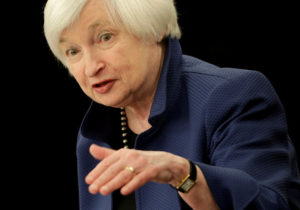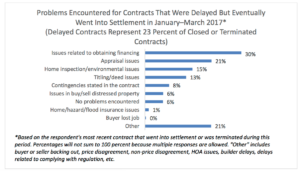
by koredesign | May 5, 2017 | LLT, News
 Mortgage rates held steady this week as mixed economic news kept them in check. News of a strengthening labor market was offset by disappointing first-quarter growth in gross domestic product.
Mortgage rates held steady this week as mixed economic news kept them in check. News of a strengthening labor market was offset by disappointing first-quarter growth in gross domestic product.
According to the latest data, released Thursday by Freddie Mac, the 30-year fixed-rate average slipped to 4.02 percent with an average 0.5 point. (Points are fees paid to a lender equal to 1 percent of the loan amount.) It was 4.03 percent a week ago and 3.61 percent a year ago.
The 15-year fixed-rate average was unchanged at 3.27 percent with an average 0.5 point. It was 2.86 percent a year ago. The five-year adjustable rate average ticked up to 3.13 percent with an average 0.5 point. It was 3.12 percent a week ago and 2.8 percent a year ago.
“Markets have been erring on the side of caution following a weak advance estimate for first-quarter GDP and the broadly expected decision to leave rates unchanged,” Sean Becketti, Freddie Mac chief economist, said in a statement.
As expected, the Federal Reserve did not raise its benchmark rate when it met this week. It is widely anticipated that its next rate increase will come next month.
The Mortgage Bankers Association “continues to forecast that the FOMC will raise rates at its meeting in June and again in September,” said Lynn Fisher, MBA vice president of research and economics. “It also remains likely that the committee will begin allowing assets to run off their balance sheet by the end of the year, which, over time, may exert upward pressure on the spread between mortgage interest rates and Treasury yields. For now, the FOMC confirmed this week that it will continue reinvesting principal so as to maintain current balance sheet levels.”
Bankrate.com, which puts out a weekly mortgage rate trend index, found that more than two-thirds of the experts it surveyed expect rates to remain relatively stable in the coming week. Elizabeth Rose, branch manager at Movement Mortgage, is one who says rates are unlikely to change much.
Continue reading.

by koredesign | May 4, 2017 | LLT, News
 Odds of June rate hike jump to 90% after statement
Odds of June rate hike jump to 90% after statement
The Federal Reserve on Wednesday left a key borrowing rate unchanged and dismissed a weak first quarter as temporary, signaling it is still on track to raise interest rates at gradual pace.
“The [Federal Open Market Committee] views the slowing in growth during the first quarter as likely to be transitory,” the statement said, in unusually dismissive language. Job gains were described as “solid,” as were the fundamentals underpinning the continued growth in consumer spending. Business fixed investment “firmed,” the central bank noted.
“The main takeaway is full steam ahead” with rate hikes, said Kathy Bostjancic, head of U.S. macro investor services at Oxford Economics.
The U.S. stock market, notably the S&P 500 index, SPX, +0.05% ended mostly lower after the statement following the release.
The decision leaves the benchmark short-term fed-funds rate in a range of 0.75% to 1%. The median forecast of Fed officials is for two additional quarter-point rate increases this year.
Investors who bet on the future path of the fed-funds rate project the next rate hike raised the odds of a move in June from 70% to 90%, Bostojancic said.
“On the whole, the statement was slightly more hawkish than we expected. On balance, we still think that the Fed will hike again in June,” agreed Paul Ashworth, chief U.S. economist at Capital Economics.
There were no dissents from the Fed’s updated policy statement.
Economic data show the U.S. economy got off to slow start in 2017 as Americans dialed back spending and companies reduced production to get inventories back in line.
Yet the economy has repeatedly picked up speed in the spring and summer, and Wednesday’s statement shows the central bankers expect the same pattern to recur.
Consumers and businesses are the most upbeat in year and early signs point to faster growth in the second quarter.
A string of higher inflation readings was also broken in March, a sign the economy had cooled off.
Continue reading.

by koredesign | May 3, 2017 | LLT, News
 For the first time in a decade, more new households chose to buy a home rather than rent one in the first quarter of 2017, according to Census Bureau data. About 854,000 new households purchased a home—more than double the 365,000 new households who chose to rent. New homeowners have not outpaced new renters since the third quarter of 2006.
For the first time in a decade, more new households chose to buy a home rather than rent one in the first quarter of 2017, according to Census Bureau data. About 854,000 new households purchased a home—more than double the 365,000 new households who chose to rent. New homeowners have not outpaced new renters since the third quarter of 2006.
The overall homeownership rate in the first quarter of 2017 was 63.6 percent, down slightly from 63.7 percent in the fourth quarter of 2016. But economists say the increase in new households who purchased could signal a turnaround in the long-term decline of the overall homeownership rate, according to The Wall Street Journal.
In the mid-2000s, the homeownership rate peaked at about 69 percent. In the second-quarter of 2016, it hit a 50-year low of 62.9 percent but has been gradually climbing since then. “People are looking at housing as being a bit more attractive, as memories of the financial crisis fade,” Joseph LaVorgna, chief U.S. economist at Deutsche Bank, told the Journal.
Indeed, existing-home sales zoomed to their strongest sales pace in a decade in March, according to the National Association of REALTORS®. New-home sales also edged up 5.8 percent in March.
Read the full article.

by koredesign | May 2, 2017 | LLT, News

Fewer respondents cite financing as an issue today than when the survey began tracking such data
Twenty-three percent of real estate professionals say they faced closing delays for a transaction in March, and 7 percent say the sale contract was terminated altogether, according to the REALTORS® Confidence Index, which is based on responses from more than 2,500 REALTORS® nationwide. Clients who had trouble obtaining financing was the most common reason for delays, respondents to the survey say, followed by appraisal issues.
Though it remains the top roadblock to closing, fewer respondents cite financing as an issue today than when the survey began tracking such data. “The decline may reflect the improvement in the economic environment, better credit histories from borrowers, and improvement in the loan evaluation processes of mortgage originations,” the report notes.
But appraisal issues are growing more common. Real estate practitioners say a shortage of appraisers, valuations that are not in line with market conditions, and “out-of-town” appraisers who are not familiar with the local market are the biggest problems they face concerning appraisals. Indeed, 55 percent of mortgage originators recently surveyed reported some level of difficulty getting appraisals, according to a separate NAR survey.
Read the full article.

by koredesign | Apr 27, 2017 | LLT, News
-
 Total mortgage application volume rose 2.7 percent last week, according to the Mortgage Bankers Association.
Total mortgage application volume rose 2.7 percent last week, according to the Mortgage Bankers Association.
-
Volume was 18 percent lower compared with the same week one year ago.
The refinance market came back to life last week, as mortgage rates fell further. Homebuyers, however, were not as easily swayed by rates.
Total mortgage application volume rose 2.7 percent, seasonally adjusted, for the week, according to the Mortgage Bankers Association. Volume was 18 percent lower compared with the same week one year ago.
Mortgage refinance volume remains far weaker than it was last year, when interest rates were lower, but it did rise 7 percent week to week as rates sank to the lowest level since just after following the presidential election. The size of the average refinance loan also increased, as large-balance borrowers are more rate sensitive. Refinances are still 34 percent below where they were a year ago.
The average contract interest rate for 30-year fixed-rate mortgages with conforming loan balances of $424,100 or less decreased to 4.20 percent from 4.22 percent, with points increasing to 0.37 from 0.35, including the origination fee, for 80 percent loan-to-value ratio loans.
“The drop was driven by continued investor concerns about the French election, though Sunday’s first-round voting results apparently have alleviated some investor fears,” said Lynn Fisher, MBA vice president of research and economics.
Homebuyers were less concerned with mortgage rates and more frustrated with the lack of homes for sale. Mortgage applications to purchase a home fell 1 percent for the week and are just 0.4 percent higher than the same week last year. The supply of homes for sale continues to drop amid strong demand and low production from the nation’s homebuilders.
Mortgage rates may eventually become a bigger concern. They began rising again this week, as investors turned from the French election to the possibility of U.S. tax reform.
“In general, investors have piled back into riskier assets like stocks because the French election reduces long-term risks to the European Union,” said Matthew Graham, chief operating officer of Mortgage News Daily. “The prospects for tax reform have a similar effect in that they encourage investors to favor riskier assets at the expense of bonds. When demand for bonds decreases relative to supply, rates move higher.”
Read the full article.

by koredesign | Apr 26, 2017 | LLT, News
 The inventory squeeze has left home buyers with fewer options on the market than they’ve seen in decades. While that’s bad news for them, the continuously high demand means it’s one of the best times to be a seller—ever.
The inventory squeeze has left home buyers with fewer options on the market than they’ve seen in decades. While that’s bad news for them, the continuously high demand means it’s one of the best times to be a seller—ever.
“I’ve been selling real estate for 25 years, and this is the strongest seller’s market I have ever seen in my entire real estate career,” David Fogg, a sales associate with Keller Williams Realty World Media Center in Burbank, Calif., told CNBC. “A lot of our sellers are optimistically pricing their homes in today’s market, and I have to say, in most cases, we’re getting the home sold anyway.” He says he recently listed what’s considered an entry-level home in the area—a three-bedroom, two-bath, 1,240-square foot home—for $789,000. The seller received three offers before Fogg held the first open house, which 100 would-be buyers attended.
“It’s very tough. Most of the listings are intentionally listed a little low to get a lot of attention, and it’s not uncommon to get 12 to 16 offers on one property,” says Jilbert Mosessian, a renter in the Burbank area who is looking to buy a home. He says he recently put offers on three homes considerably higher than their listing prices, “and I was told that there were still five people above me and [the seller was] only going to deal with them.”
The inventory of homes for sale decreased by 6.6 percent at the end of March compared to a year ago, according to the National Association of REALTORS®. Unsold housing inventory is at a 3.8-month supply. Most economists consider a balanced market to be a five- to six-month supply. Forty-eight percent of homes in March sold in less than a month.
To better compete, buyers are dropping contingencies and offering more cash down. Real estate professionals also are bracing their clients for potential appraisal issues because in hot markets, homes may appraise below the bid-up sale price.
Continue reading.

 Mortgage rates held steady this week as mixed economic news kept them in check. News of a strengthening labor market was offset by disappointing first-quarter growth in gross domestic product.
Mortgage rates held steady this week as mixed economic news kept them in check. News of a strengthening labor market was offset by disappointing first-quarter growth in gross domestic product.




Recent Comments